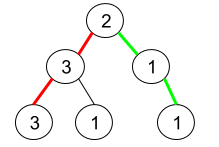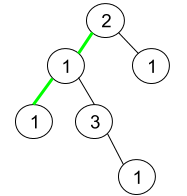LeetCode 솔루션 분류
[9/14] 1457. Pseudo-Palindromic Paths in a Binary Tree
본문
Medium
187662Add to ListShareGiven a binary tree where node values are digits from 1 to 9. A path in the binary tree is said to be pseudo-palindromic if at least one permutation of the node values in the path is a palindrome.
Return the number of pseudo-palindromic paths going from the root node to leaf nodes.
Example 1:

Input: root = [2,3,1,3,1,null,1] Output: 2 Explanation: The figure above represents the given binary tree. There are three paths going from the root node to leaf nodes: the red path [2,3,3], the green path [2,1,1], and the path [2,3,1]. Among these paths only red path and green path are pseudo-palindromic paths since the red path [2,3,3] can be rearranged in [3,2,3] (palindrome) and the green path [2,1,1] can be rearranged in [1,2,1] (palindrome).
Example 2:

Input: root = [2,1,1,1,3,null,null,null,null,null,1] Output: 1 Explanation: The figure above represents the given binary tree. There are three paths going from the root node to leaf nodes: the green path [2,1,1], the path [2,1,3,1], and the path [2,1]. Among these paths only the green path is pseudo-palindromic since [2,1,1] can be rearranged in [1,2,1] (palindrome).
Example 3:
Input: root = [9] Output: 1
Constraints:
- The number of nodes in the tree is in the range
[1, 105]. 1 <= Node.val <= 9
Accepted
88,348
Submissions
129,778
관련자료
-
링크
댓글 1
학부유학생님의 댓글
- 익명
- 작성일
Runtime: 1255 ms, faster than 66.67% of Python3 online submissions for Pseudo-Palindromic Paths in a Binary Tree.
Memory Usage: 84.7 MB, less than 86.60% of Python3 online submissions for Pseudo-Palindromic Paths in a Binary Tree.
Memory Usage: 84.7 MB, less than 86.60% of Python3 online submissions for Pseudo-Palindromic Paths in a Binary Tree.
# Definition for a binary tree node.
# class TreeNode:
# def __init__(self, val=0, left=None, right=None):
# self.val = val
# self.left = left
# self.right = right
from collections import Counter
class Solution:
def pseudoPalindromicPaths (self, root: Optional[TreeNode]) -> int:
# set elements == 0: all even
# set elements == 1: all even except one
# set elements >=2 : cannot be palindrome
elements = set()
def dfs(node):
if not node: return 0
# modify set
if node.val not in elements: elements.add(node.val)
else: elements.remove(node.val)
if not node.left and not node.right:
return_val = 1 if len(elements)<=1 else 0
else:
return_val = dfs(node.left) + dfs(node.right)
# UNDO the modification from the above for other dfs
if node.val not in elements: elements.add(node.val)
else: elements.remove(node.val)
return return_val
return dfs(root)









